What is Incomplete Dominance?
- Incomplete dominance is a fundamental concept in genetics that describes a unique pattern of inheritance. This genetic phenomenon was first identified by Carl Correns, a German botanist, who explored the inheritance patterns in the plant Mirabilis jalapa, commonly known as four o’clock flowers.
- In incomplete dominance, the phenotype of a heterozygous individual is an intermediate blend of the phenotypes associated with the two homozygous alleles. Unlike complete dominance, where the dominant allele masks the effect of the recessive allele, incomplete dominance results in a distinct, intermediate trait. For instance, when red-flowered and white-flowered four o’clock plants are crossed, the offspring display pink flowers, a phenotype that is not found in either parent but rather a blend of both.
- The genetic ratios observed in incomplete dominance are consistent with those seen in complete dominance. Specifically, a typical cross involving two heterozygous parents will produce a 1:2:1 genotypic ratio and a similar 1:2:1 phenotypic ratio. This is because the heterozygous genotype leads to an expression of a trait that is neither fully dominant nor recessive.
- The concept of incomplete dominance highlights the fact that neither allele is completely dominant over the other. Instead, the resulting trait is a combination of the two alleles, leading to a phenotype that is intermediate between the two parental traits. This contrasts with Mendelian genetics, where the dominant allele would completely mask the recessive allele.
- Incomplete dominance plays a significant role in the diversity of traits within populations. It emphasizes that gene expression can result in a range of phenotypic outcomes, rather than the binary dominant/recessive outcomes observed in complete dominance. This phenomenon broadens our understanding of genetic inheritance by illustrating how alleles interact to produce varying levels of trait expression.
Definition of Incomplete Dominance
Incomplete dominance is a genetic scenario where the heterozygous phenotype is an intermediate blend of the two homozygous phenotypes, with neither allele being fully dominant or recessive.
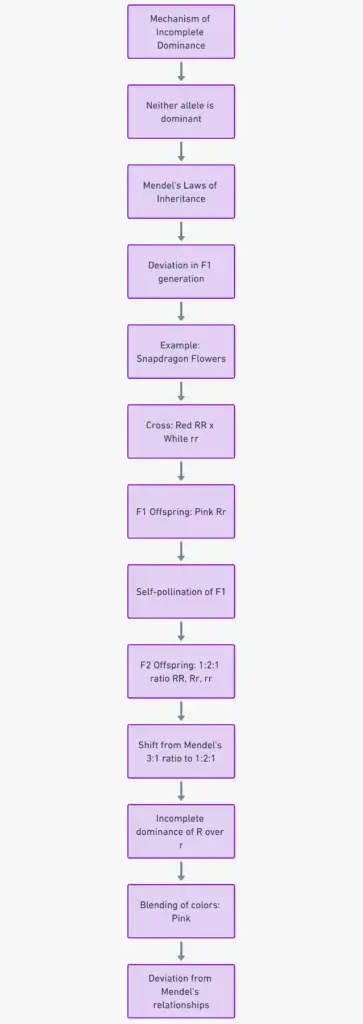
Concept of Dominance
In genetics, the concept of dominance revolves around the relationship between alleles of a single gene. To truly grasp this concept, it’s essential to delve into the nature of genes themselves.
Genes, as we understand, are fundamental units of heredity found in organisms. They exist in pairs of alleles within diploid organisms, where these pairs can either be similar or dissimilar. In other words, heterozygous genes comprise two different alleles, while homozygous genes possess two identical alleles.
The presence of dissimilar alleles in heterozygous individuals introduces the concept of dominance. When we assert that one trait is dominant over another, there are typically two reasons for this:
- Non-Functionality: In some cases, the recessive allele might be functionally impaired, unable to carry out its intended role. As a result, the dominant allele effectively masks the recessive allele’s effects, leading to the expression of only the dominant trait.
- Reduced Activity: Alternatively, the recessive allele might be less active or efficient compared to the dominant allele. This diminished activity can result in a weaker expression of the trait associated with the recessive allele, making the dominant allele’s trait more prominent.
The concept of dominance provides a framework for understanding how certain alleles exert more influence over the phenotype in heterozygous individuals, shaping the observable characteristics of organisms. Through the interplay of dominant and recessive alleles, the genetic landscape gives rise to the diverse array of traits observed in various species.
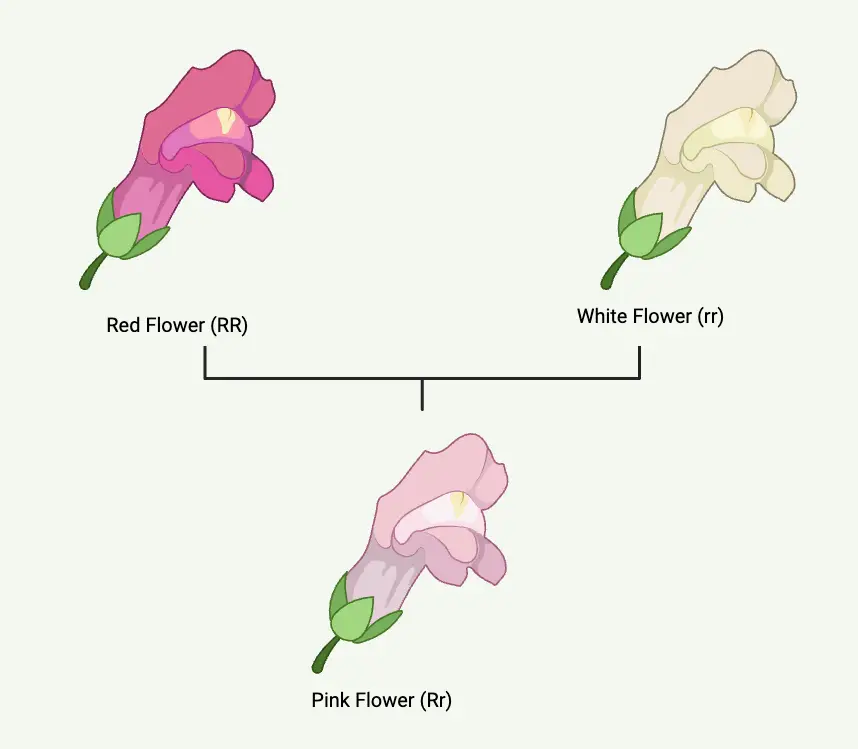
How does incomplete dominance work? – Mechanism of incomplete dominance
To understand how incomplete dominance operates, it is essential to examine the genetic mechanisms involved. Incomplete dominance is a type of genetic inheritance where neither allele is completely dominant over the other, resulting in an intermediate phenotype in the heterozygous condition. The following points elucidate the process:
- Genotype Representation: In incomplete dominance, alleles are represented by different letters to signify their role in determining the phenotype. For instance, in snapdragons, red flowers are denoted by the homozygous genotype RR, while white flowers are denoted by rr.
- Punnett Square Analysis: Geneticists use a Punnett square to predict the outcome of crosses involving incomplete dominance. By crossing a red-flowered (RR) plant with a white-flowered (rr) plant, the Punnett square reveals that all offspring in the first filial generation (F1) will be heterozygous (Rr), displaying an intermediate pink color.
- Phenotypic Expression: In the F1 generation, the phenotype is a blend of the two parental traits. The pink flowers in this generation are not due to a dominance of one allele but rather a combination of the red and white alleles, resulting in an intermediate expression.
- F2 Generation Results: When F1 heterozygotes (Rr) are crossed, the resulting F2 generation exhibits a genotypic ratio of 1:2:1. This ratio includes homozygous red (RR), heterozygous pink (Rr), and homozygous white (rr) plants. The phenotypic ratio in the F2 generation will mirror this genotypic ratio, displaying red, pink, and white flowers in equal proportions.
- Implications of Incomplete Dominance: Incomplete dominance demonstrates that alleles do not always exhibit a clear dominance relationship. Instead, the resulting phenotype is a mixture of the contributions from both alleles. This contrasts with complete dominance, where one allele masks the effect of the other.
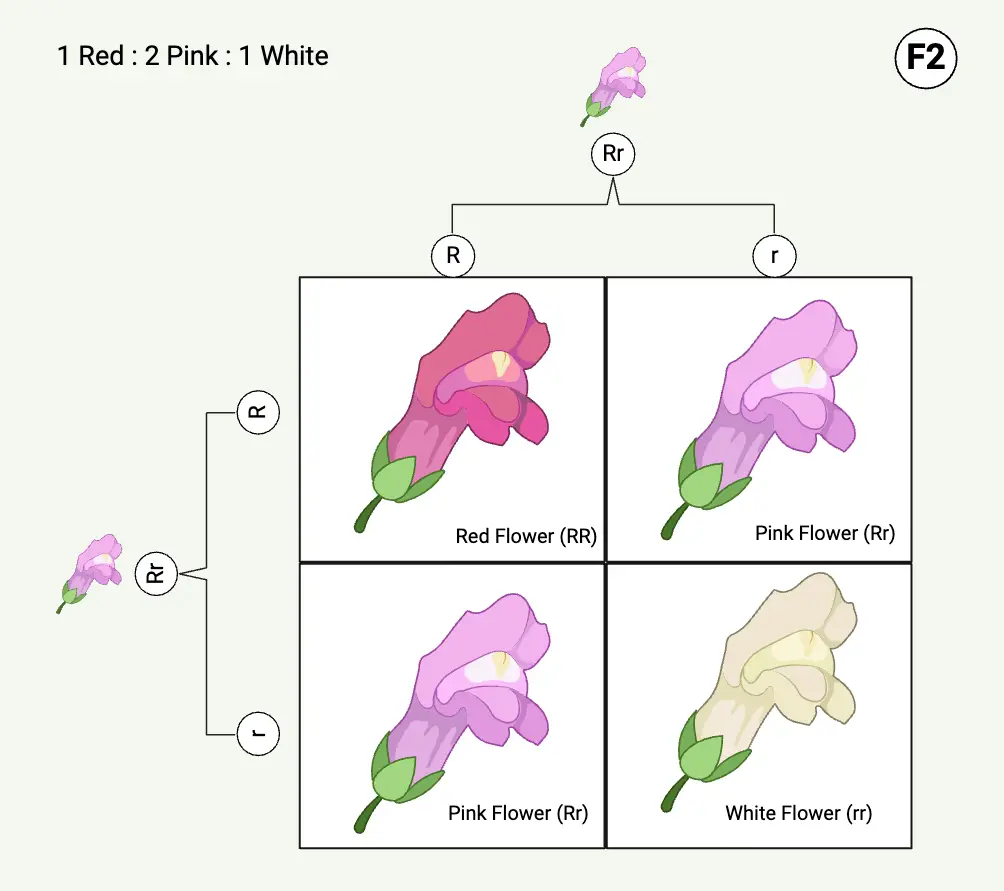
Incomplete dominance illustrates that genetic interactions can produce a spectrum of phenotypes. The intermediate traits observed in the F1 generation and the segregation of traits in the F2 generation confirm that incomplete dominance results in blending inheritance rather than the strict dominant-recessive patterns seen in complete dominance.
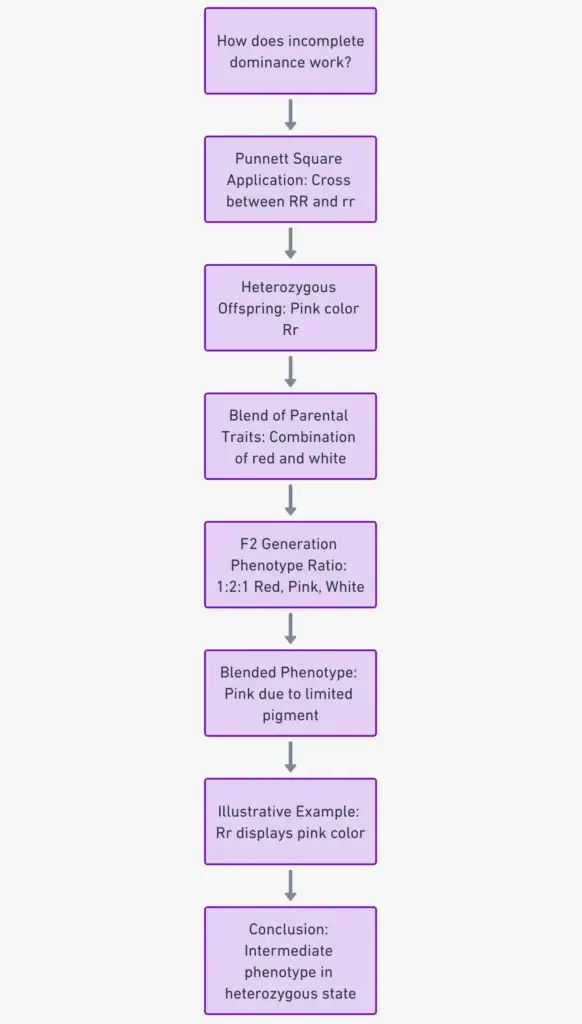
Examples of Incomplete Dominance
Incomplete dominance can be observed across various organisms, including plants, animals, and humans. Each example provides insight into how this genetic mechanism operates in different contexts.
Incomplete Dominance in Plants
- Carnations: The phenomenon of incomplete dominance was first identified in carnations. When true-breeding red and white carnations were crossed, the resulting offspring displayed pink flowers, an intermediate phenotype.
- Four O’clock Flowers: Another classic example is found in Mirabilis jalapa, or four o’clock flowers. Crossing red-flowered and white-flowered plants yields progeny with pink flowers, demonstrating an intermediate phenotype where neither color is dominant.
- Snapdragons: In snapdragons, the cross between red and white flowers produces pink flowers, illustrating incomplete dominance where the heterozygous phenotype is a blend of the two parental traits.
- Eggplants: The light violet color observed in eggplants is due to incomplete dominance. When deep purple eggplants are crossed with white eggplants, the offspring exhibit an intermediate violet color.
Incomplete Dominance in Animals
- Andalusian Chickens: This breed of chicken exhibits incomplete dominance. When a white-feathered male is crossed with a black-feathered female, the offspring have blue or grayish feathers due to the partial expression of both color genes.
- Rabbits: In rabbits, breeding long-haired and short-haired individuals results in offspring with medium-length fur, demonstrating a blend of both parental traits.
- Dogs: Crossing a long-tailed dog with a short-tailed dog can produce offspring with medium-length tails, showing an intermediate trait.
- Spotted Animals: Some animals, such as dogs, cats, and horses, exhibit incomplete dominance in their coat patterns. Crossing a spotted animal with a non-spotted one results in offspring with fewer spots, illustrating how incomplete dominance affects trait expression.
Incomplete Dominance in Humans
- Hair Texture: In humans, incomplete dominance can affect hair texture. When individuals with straight and curly hair have children, the offspring may have wavy or semi-curly hair, representing a blend of the parents’ traits.
- Height: Human height also demonstrates incomplete dominance. Children of parents with varying heights often fall between the heights of the parents, rather than exactly matching one parent’s height.
- Tay Sachs Disease: This autosomal recessive condition exhibits partial dominance. Carriers of Tay Sachs disease produce only half of the necessary enzyme, leading to a milder effect compared to those with the disease.
- Familial Hypercholesterolemia (FH): This condition is another example of incomplete dominance. Individuals with FH have liver cells that lack enough cholesterol receptors, resulting from the interaction of alleles that produce a partial effect on receptor production.
Incomplete dominance vs. Codominance
Incomplete dominance and codominance are two genetic mechanisms that describe how alleles interact in heterozygous organisms. Although both involve the expression of multiple alleles, they result in different phenotypic outcomes.
Incomplete Dominance
- Definition: Incomplete dominance occurs when neither allele is completely dominant. As a result, the heterozygous phenotype is an intermediate blend of the two parental traits.
- Phenotype: The phenotype of the heterozygote is a mix of the parental traits, creating a new, intermediate appearance. For example, crossing red and white flowers might produce pink flowers.
- Expression of Alleles: Both alleles contribute to the phenotype, but neither allele fully masks the effect of the other. This blending results in an intermediate trait that is different from both parental phenotypes.
- Parental Phenotype: The offspring’s phenotype does not directly resemble either parent but rather represents a blend of both.
- Dominance Relationship: There is no complete dominance-recessive relationship in incomplete dominance. The dominant allele does not overshadow the recessive allele but rather merges with it.
- Examples: Examples include the pink flowers of Mirabilis jalapa (four o’clock flowers) and intermediate traits in human physical characteristics like hair color, hand size, and height.
Codominance
- Definition: Codominance occurs when both alleles in a heterozygote are fully expressed, and neither allele is dominant over the other. This results in the simultaneous display of both parental traits.
- Phenotype: The phenotype exhibits both alleles distinctly without blending. For example, an individual with codominant alleles for blood type might display both A and B antigens on the red blood cells.
- Expression of Alleles: In codominance, both alleles are expressed equally and visibly in the phenotype. There is no intermediate phenotype; instead, both traits are apparent.
- Parental Phenotype: The offspring display both parental phenotypes clearly and distinctly.
- Dominance Relationship: Codominance does not involve a dominant-recessive relationship. Both alleles are expressed independently and fully.
- Examples: Examples include human blood types (A, B, AB, O) and certain animal coat patterns, such as spotted feathers or fur in livestock.
Key Differences
- Phenotypic Outcome: Incomplete dominance results in an intermediate phenotype that blends parental traits, while codominance results in the distinct and simultaneous expression of both parental traits.
- Allele Interaction: In incomplete dominance, neither allele is fully dominant; instead, the trait is a mixture. In codominance, both alleles are fully expressed without blending.
- Examples: Incomplete dominance can be seen in flower colors and various human traits, whereas codominance is observed in blood types and certain animal markings.
Incomplete dominance vs. Codominance Chart
| Aspect | Incomplete Dominance | Codominance |
|---|---|---|
| Definition | Dominant allele incompletely dominates recessive | Both alleles from homozygous parents are equally expressed |
| Phenotype | Intermediate blend of parental traits | Both parental traits expressed independently |
| Expression of Alleles | Both alleles contribute to phenotype | Both alleles have equal chance of expression |
| Parental Phenotype | Offspring phenotype distinct from parents | Offspring phenotype displays both parents’ traits |
| Dominance Relationship | No clear dominant-recessive relationship | No dominance relationship |
| Examples | Pink flowers (four o’clock), human traits (hair color, hand size, height) | Human blood types (A, B, AB, O), animal traits (spotted feathers, hairs) |
Incomplete Dominance Infograph
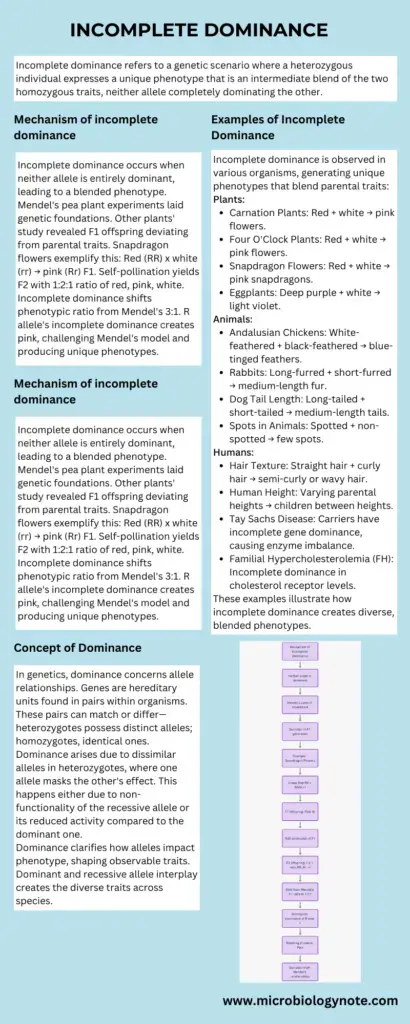
Mindmap on Incomplete Dominance
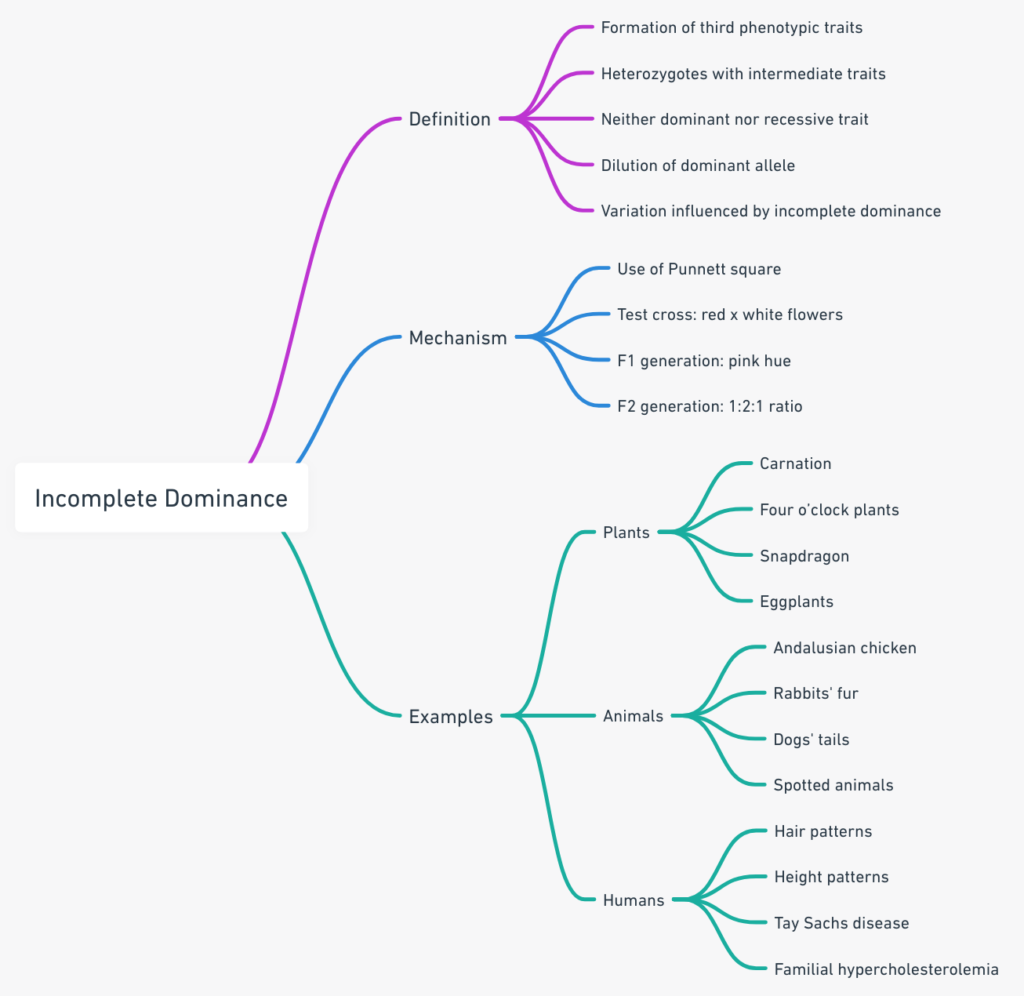
FAQ
What is incomplete dominance?
Incomplete dominance is a genetic phenomenon where the heterozygous offspring display an intermediate phenotype that is a blend of the phenotypes of the two homozygous parental traits.
How does incomplete dominance differ from complete dominance?
In complete dominance, the dominant allele fully masks the recessive allele’s effect, leading to a clear dominant phenotype. In incomplete dominance, neither allele dominates, resulting in an intermediate phenotype.
What is an example of incomplete dominance?
An example is the color of snapdragon flowers. When red and white flowers are crossed, the offspring have pink flowers, representing incomplete dominance.
What is the genotypic and phenotypic ratio in incomplete dominance?
The genotypic ratio is 1:2:1 (RR:Rr:rr), and the phenotypic ratio is also 1:2:1 (red:pink:white).
Can incomplete dominance result in new alleles?
No, incomplete dominance involves the expression of existing alleles in a unique way, creating an intermediate phenotype.
Can incomplete dominance be observed in humans?
Yes, traits like hair texture, hand size, and voice pitch exhibit incomplete dominance.
How is incomplete dominance represented in Punnett squares?
In Punnett squares, incomplete dominance is shown by capital letters for alleles and blending the colors to indicate the intermediate phenotype.
Is the Law of Segregation applicable to incomplete dominance?
Yes, the Law of Segregation still holds true in incomplete dominance. Alleles segregate during gamete formation.
What is the relationship between alleles in incomplete dominance?
In incomplete dominance, neither allele is completely dominant over the other. Both alleles contribute to the phenotype.
How is incomplete dominance different from codominance?
In incomplete dominance, an intermediate phenotype results from blending alleles. In codominance, both alleles are expressed independently, leading to a combined phenotype without blending.
- Frizzell, M. A. (2013). Incomplete Dominance. Brenner’s Encyclopedia of Genetics, 58–60. doi:10.1016/b978-0-12-374984-0.00784-1
- Piercy, R. J., & Rivero, J.-L. L. (2014). Muscle disorders of equine athletes. Equine Sports Medicine and Surgery, 109–143. doi:10.1016/b978-0-7020-4771-8.00007-7
- https://www.sciencefacts.net/incomplete-dominance.html
- https://www.biologyonline.com/dictionary/incomplete-dominance
- https://www.khanacademy.org/science/biology/classical-genetics/variations-on-mendelian-genetics/a/multiple-alleles-incomplete-dominance-and-codominance
- https://biologydictionary.net/incomplete-dominance/
- https://unacademy.com/content/neet-ug/study-material/biology/incomplete-dominance/
- https://collegedunia.com/exams/incomplete-dominance-biology-articleid-221
- Text Highlighting: Select any text in the post content to highlight it
- Text Annotation: Select text and add comments with annotations
- Comment Management: Edit or delete your own comments
- Highlight Management: Remove your own highlights
How to use: Simply select any text in the post content above, and you'll see annotation options. Login here or create an account to get started.